The Crucial/Micron M500 Review (960GB, 480GB, 240GB, 120GB)
by Anand Lal Shimpi on April 9, 2013 9:59 AM ESTAnandTech Storage Bench 2011
Two years ago we introduced our AnandTech Storage Bench, a suite of benchmarks that took traces of real OS/application usage and played them back in a repeatable manner. I assembled the traces myself out of frustration with the majority of what we have today in terms of SSD benchmarks.
Although the AnandTech Storage Bench tests did a good job of characterizing SSD performance, they weren't stressful enough. All of the tests performed less than 10GB of reads/writes and typically involved only 4GB of writes specifically. That's not even enough exceed the spare area on most SSDs. Most canned SSD benchmarks don't even come close to writing a single gigabyte of data, but that doesn't mean that simply writing 4GB is acceptable.
Originally I kept the benchmarks short enough that they wouldn't be a burden to run (~30 minutes) but long enough that they were representative of what a power user might do with their system.
Not too long ago I tweeted that I had created what I referred to as the Mother of All SSD Benchmarks (MOASB). Rather than only writing 4GB of data to the drive, this benchmark writes 106.32GB. It's the load you'd put on a drive after nearly two weeks of constant usage. And it takes a *long* time to run.
1) The MOASB, officially called AnandTech Storage Bench 2011 - Heavy Workload, mainly focuses on the times when your I/O activity is the highest. There is a lot of downloading and application installing that happens during the course of this test. My thinking was that it's during application installs, file copies, downloading and multitasking with all of this that you can really notice performance differences between drives.
2) I tried to cover as many bases as possible with the software I incorporated into this test. There's a lot of photo editing in Photoshop, HTML editing in Dreamweaver, web browsing, game playing/level loading (Starcraft II & WoW are both a part of the test) as well as general use stuff (application installing, virus scanning). I included a large amount of email downloading, document creation and editing as well. To top it all off I even use Visual Studio 2008 to build Chromium during the test.
The test has 2,168,893 read operations and 1,783,447 write operations. The IO breakdown is as follows:
| AnandTech Storage Bench 2011 - Heavy Workload IO Breakdown | ||||
| IO Size | % of Total | |||
| 4KB | 28% | |||
| 16KB | 10% | |||
| 32KB | 10% | |||
| 64KB | 4% | |||
Only 42% of all operations are sequential, the rest range from pseudo to fully random (with most falling in the pseudo-random category). Average queue depth is 4.625 IOs, with 59% of operations taking place in an IO queue of 1.
Many of you have asked for a better way to really characterize performance. Simply looking at IOPS doesn't really say much. As a result I'm going to be presenting Storage Bench 2011 data in a slightly different way. We'll have performance represented as Average MB/s, with higher numbers being better. At the same time I'll be reporting how long the SSD was busy while running this test. These disk busy graphs will show you exactly how much time was shaved off by using a faster drive vs. a slower one during the course of this test. Finally, I will also break out performance into reads, writes and combined. The reason I do this is to help balance out the fact that this test is unusually write intensive, which can often hide the benefits of a drive with good read performance.
There's also a new light workload for 2011. This is a far more reasonable, typical every day use case benchmark. Lots of web browsing, photo editing (but with a greater focus on photo consumption), video playback as well as some application installs and gaming. This test isn't nearly as write intensive as the MOASB but it's still multiple times more write intensive than what we were running in 2010.
As always I don't believe that these two benchmarks alone are enough to characterize the performance of a drive, but hopefully along with the rest of our tests they will help provide a better idea.
The testbed for Storage Bench 2011 has changed as well. We're now using a Sandy Bridge platform with full 6Gbps support for these tests.
AnandTech Storage Bench 2011 - Heavy Workload
We'll start out by looking at average data rate throughout our new heavy workload test:
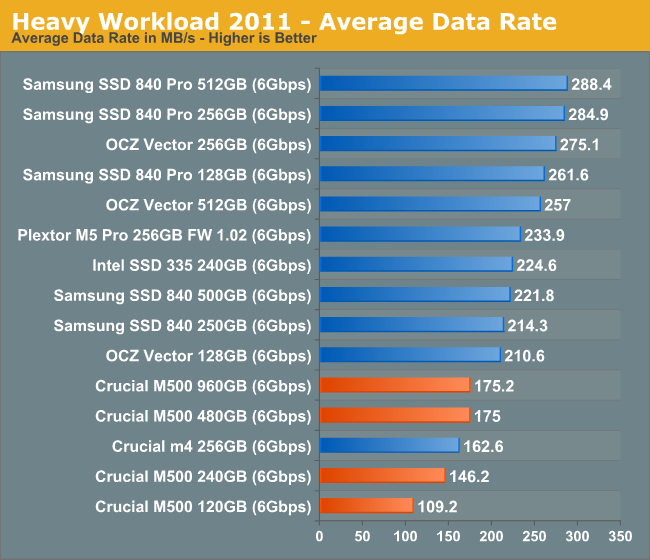
Our heavy workload from 2011 illustrates the culmination of everything we've shown thus far: the M500 can even be slower than the outgoing m4. There's no doubt in my mind that this is a result of the tradeoffs associated with moving to 128Gbit NAND die. The M500's performance is by no means bad, but it's definitely below what we've come to expect from Intel and Samsung flagships.
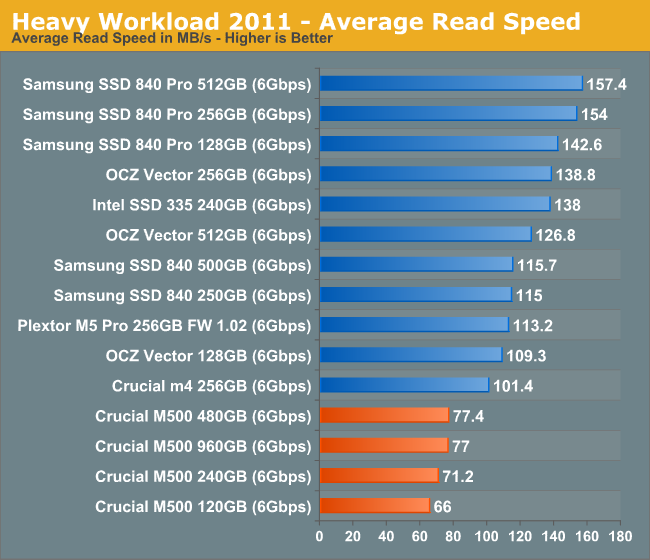
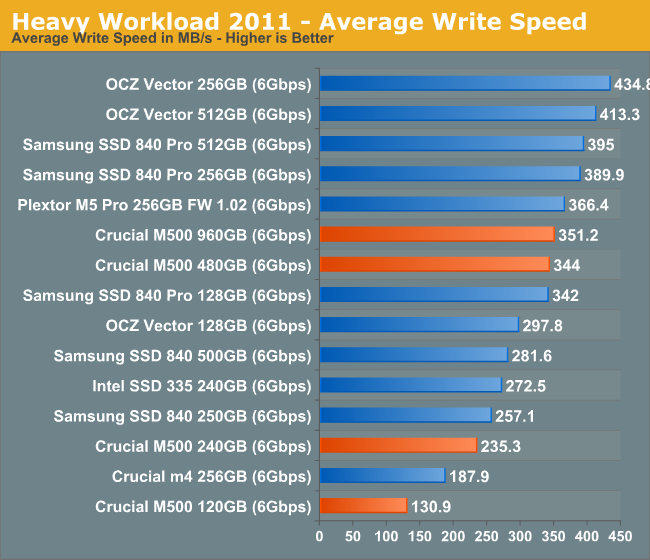
The next three charts just represent the same data, but in a different manner. Instead of looking at average data rate, we're looking at how long the disk was busy for during this entire test. Note that disk busy time excludes any and all idles, this is just how long the SSD was busy doing something:
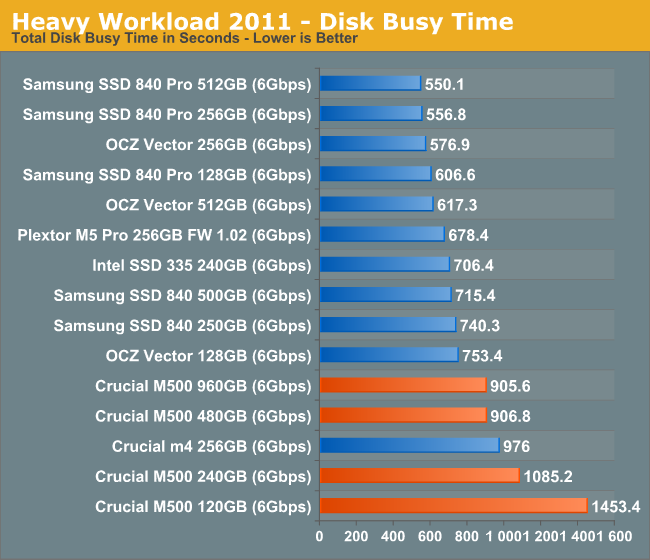
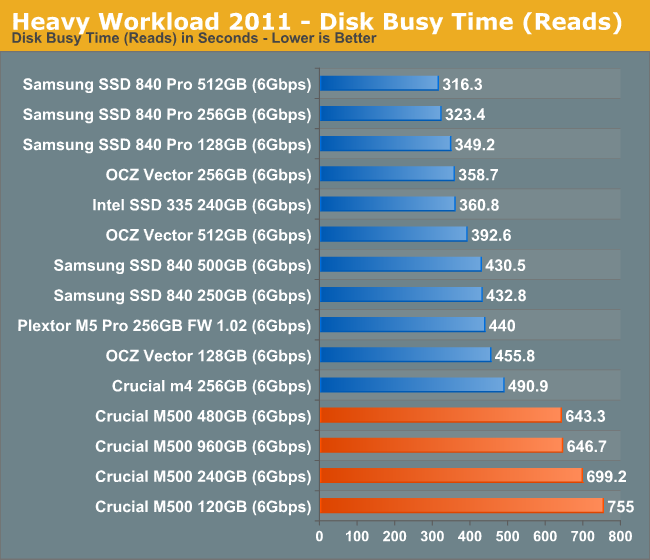
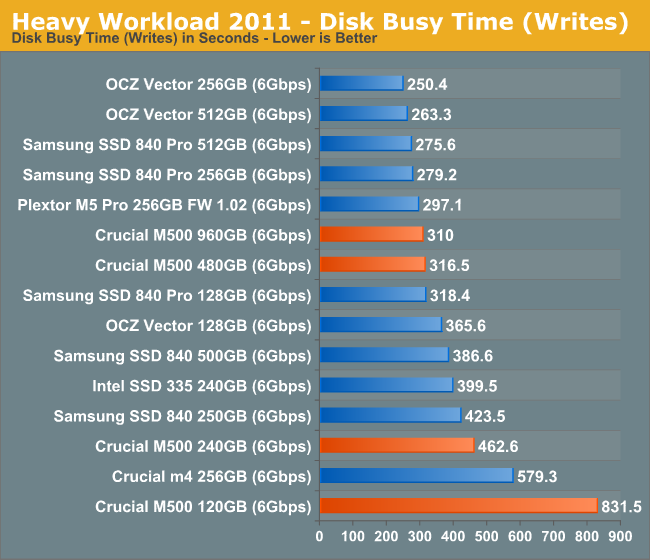










111 Comments
View All Comments
philipma1957 - Thursday, April 18, 2013 - link
it is all about how much you want to pay. if you buy 1 960gb micron ssds and buy a pegasus r4. with 41tb hdds you can get a very fast booting mac setup. cost is 600 + 999 or 1600. pull one 1tb hdd from the pegasus and put in the micron 960gb ssd. you have a 1tb ssd as your boot drive and 3 x 1tb hdds for storage along with a 1tb hdd as a spare.. but that is a 1600 solution pretty high costUmika - Monday, April 22, 2013 - link
I have now one of these M500 SSDs and I have actually managed to lock me out of the drive using 3rd party OPAL TCG software. Now the printed PSID comes into play: I have downloaded the Seagate SeaTools utilities for Windows to try to crypto erase the SSD, but to no avail - the SeaTools always terminate with an error message. Is there any other openly available software to try to erase or PSID revert the drive to factory settings?gzon - Tuesday, April 23, 2013 - link
I am also experiencing problems with the OPAL encryption. Windows 8 does not seem to revert the disk back to manufactured-inactive state. Also tried PSID revert with SeaTools but it did not work. Where can I find software to PSID revert the disk?mikato - Tuesday, April 23, 2013 - link
"the key is just stored in the controller and everything is encrypted/decrypted on the fly"What happens if the controller breaks somehow and you need data recovery? You're just screwed? Of course backing up is the best way to go but we all know not many people do that and with these large SSD sizes they'll be taking on more data and not just an OS and programs that can always be reinstalled.
odedia - Sunday, July 21, 2013 - link
I can just drool over the thought of putting two of these in my 17 inch Macbook Pro. I currently have a 128gb Intel SSD and a 500gb spinning drive. This will be a serious upgrade, and I'll be able to RAID0 them together for better performance and easier drive management.littlesandra88 - Tuesday, August 27, 2013 - link
How can an ATA BIOS password not be secure, if it changes the password (makes a new hash)?paaraa - Friday, November 29, 2013 - link
People always keep hammering about the Samsung SSD's, but did you know about the bad block issue they have? Look up the 'SSD Endurnce Experiment' (the 200TB update) at Tech Report and you will see the bad block tally of the Samsung being way up there.New Egg current (black friday) has the 480gb M500 on sale for $279, pretty good. I have two M4's (128gb) and they have been great for years now.
Gallopsu - Monday, December 23, 2013 - link
This article mentions increased performance by 25% over provisiong. Is this something that must be configured in the bios or firmware. Or is it accomplished by simply not filling it to capacity. Or should only format it to 768GB and leave the rest untouched? How can I confirm that it is actually working? Would hate to give up that space and not get the benefits.clifforama - Tuesday, January 21, 2014 - link
Have you had any response from Crucial regarding how to perform a PSID reset/revert?bogdan_kr - Thursday, January 23, 2014 - link
Yes, I would like to know that too. Crucial has not provided any information on their forums but I guess they could possibly send some more specific information to you Anand :-)